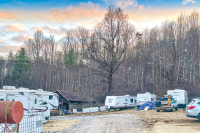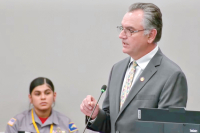Learning to treat injuries in the wild
What can you do with a foam pad, rain pants, sleeping bag and an old T-shirt?
A whole lot apparently, according to students who have been through wilderness medical training with Landmark Learning.
Broken leg? No problem. Dislocated shoulder? Gotcha covered. If you get hurt in the backcountry, just keep your fingers crossed one of these guys will find you.
“We teach a lot of improvisation,” said Rob Barham, one of Landmark’s regular instructors.
During a recent course, Barham walked students through the finer points of fashioning a full-leg cast on the fly to stabilize a torn ACL.
“This is mimicking a commercial knee splint with materials you would typically have in your backpack,” said Barham, 34, who lives in Jackson County.
Related Items
Landmark, based in Cullowhee, offers dozens of outdoor rescue and wilderness medical training courses every year. The most advanced course is a Wilderness EMT, a four-week course that equips students to do everything from drive an ambulance in an urban setting to treat major medical emergencies far from civilization.
A recent wilderness EMT course conducted by Landmark attracted people from across the country and from all walks of the outdoor industry: camp counselors, outfitters, park rangers, you name it.
“We have a lot of injuries in the backcountry, and rangers are the first person to come up on them,” said Kathleen Fleet, 23, a park ranger at Carlsbad Caverns who came for the training.
Two students claiming the longest distance traveled dropped in from Antarctica. They are usually stationed on a ship funded by the National Science Foundation, which hosts rotating research teams every few months off the Antarctic coast. Medical training in such remote surrounds seemed like a wise undertaking.
The course also attracted college students studying to be doctors and nurses — including some already in the profession.
Robin Pope, a physician’s assistant with Sylva Orthopedic Associates, obviously had the basic medical knowledge of the EMT training under his belt already. So he joined the class for only the final week, when instruction shifts to the wilderness module.
Pope is the scout master of his son’s troop and wanted to adjust his thinking to treating emergencies on camping trips versus a clinical setting.
“When a patient comes into the office, it’s a controlled setting, the light is good, the temperature isn’t freezing,” Pope said.
But outdoors, it’s an entirely different ballgame with factors out of your control.
“What do you do with six or seven other kids sitting around looking at you going ‘What are you going to do about this?’” Pope said. “It’s just kind of a different way of thinking.”
Sometimes treating injuries in the backcountry requires a heavy dose of psychology, said Justin Padgett, the owner of Landmark who often leads courses.
“If someone has had a fractured femur in the backcountry, what do they need? Your ensolite pad and fleece, or a surgeon? They need a surgeon, so your ensolite and fleece has to look really good,” Padgett told students as he walked them through yet another leg brace exercise.
After Padgett surrounded the leg of a willing volunteer with stout sticks and a rolled up sleeping pad, snugged in with anything fleece he could get his hands on, he began compressing it with torn strips of T-shirt to create a rigid unmovable mass.
“Be super intentional with your padding. Epically intentional if you will,” Padgett said. “Some people call it anal retentive. That’s not what this is. I call it ‘specificness.’”
Following the demo, students broke into teams of three to try their own hand at stabilizing each other’s legs.
“Once you have a winner, take it apart and build another winner,” Padgett said as he moved around the room critiquing the splints.
The students by now were used to serving as each other’s patients, whether it was building arm slings or manhandling each other into stretchers. The repeated hands-on practice would allow students to let their instincts and training kick in when faced with a real emergency in the field.
The climax of the course was a series of mock rescue exercises staged in the woods the final two days. Volunteer patients were decked out with fake blood and given scripts to follow during the rescue scenario.
The rescuers realized the most difficult part of treating wilderness emergencies can be the diagnosis. Extracting information from a half-passed out screaming patient on the verge of panic isn’t easy. A rock climber that falls from a cliff could be paralyzed, or merely have a dislocated shoulder, requiring a litany of field tests.
“When you ask them if they can move, there is a difference between I can’t and I won’t. Sometimes you have to be commanding and tell them ‘I need you to move on the count of three. One, two, three, go,’” Padgett said. “We need to know do they have neurological damage or do they have pain?”








